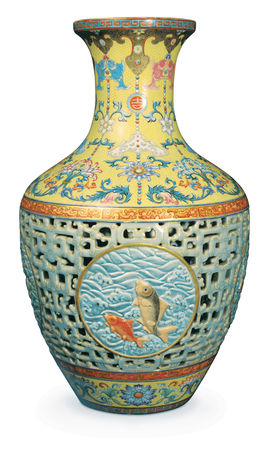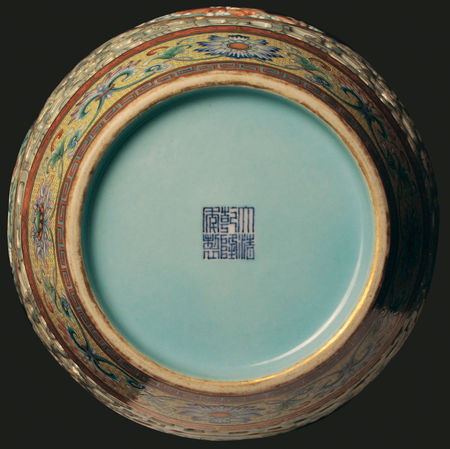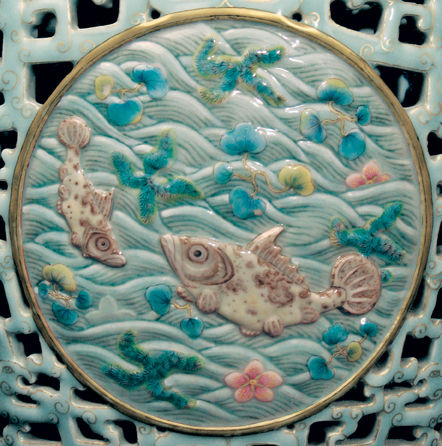An 18th century Chinese porcelain vase sold for 43 million pounds ($69.3 million).
A Superb and Very Rare yang cai Reticulated Double-Walled Vase, six-character mark in underglaze blue of Qianlong and of the period. photos Bainbridges auction
The ovoid body pierced with a broad band of celadon-glazed archaic-inspired linked angular chilong dragons, outlined in gilding and reserved with four solid roundels depicting pairs of different fish, masterfully carved, painted in iron-red and bistre and enamelled: one of carp leaping in turbulent water, the others of fish playfully swimming among floating weed and flowers picked out in pale pink and other enamels, the carving of the waves subtly enhanced with pale highlights and darker shadows;
The inner wall painted overall in strong underglaze blue with scrolling flowers in Ming style, with typical simulated ‘heaping and piling’;
The reticulated band with a narrow border above and below, of chilong dragons in shaded iron-red on a solid gilt ground between blue enamel lines;
The trumpet neck and shoulders with a ground of primrose yellow delicately pencilled with a Y pattern in pink, and reserved with twin fish, musical stones, ji medallions and flowers with scrolling foliage on bead chains, mainly in shaded famille rose enamels in the Western style, pendent from rui-headed lappets in bistre and iron-red;
The base with conforming flowers and yellow ground;
The mouth and base each with a key-fret band in pale turquoise on iron-red;
The mouth in solid sky-blue enamel extending internally to the top of the shoulder, and with gilt rim;
PROVENANCE: An English family collection - believed to have been acquired during the 1930s or earlier.
This vase combines various differing decorative elements in a manner typical of Tang Ying’s directorship of the Imperial manufactory at Jingdezhen during the early years of the reign of the Qianlong emperor – a period of remarkable technical achievement, of which it is a worthy example.
The recent exhibition at the National Palace Museum, Taipei, ‘Stunning Decorative Porcelains from the Ch’ien-lung Reign’ focused upon many of the pieces of this type in the collection, which includes:
- a vase of related form, on the cover of the exhibition catalogue;
a revolving blue-ground vase, with famille rose fish of related type upon the inner wall;
- a bottle with comparable celadon reticulation and similar gilding, with blue and white floral decoration to the inner wall.
Although the enamelled decoration of the neck and base is of a recognised type, the ground would appear to be unusual in this context whilst occurring on export wares of the period.
LONDON. - Auctioneer Peter Bainbridge holds up the Bainbridges auction catalogue showing the vase that he auctioned Thursday, in London, Friday, Nov. 12, 2010. The 18th century Chinese porcelain vase, discovered when a house was cleared out, was sold for 43 million pounds ($69.3 million). The amount was thought to be among the highest ever paid for any Chinese artwork sold at auction. AP Photo/Kirsty Wigglesworth.

/https%3A%2F%2Fprofilepics.canalblog.com%2Fprofilepics%2F1%2F0%2F100183.jpg)










/http%3A%2F%2Fp9.storage.canalblog.com%2F92%2F51%2F119589%2F98216442.jpg)
/https%3A%2F%2Fassets.over-blog.com%2Ft%2Fcedistic%2Fcamera.png)
/https%3A%2F%2Fstorage.canalblog.com%2F77%2F60%2F577050%2F66527770_o.jpg)
/https%3A%2F%2Fstorage.canalblog.com%2F91%2F69%2F577050%2F66524735_o.jpg)